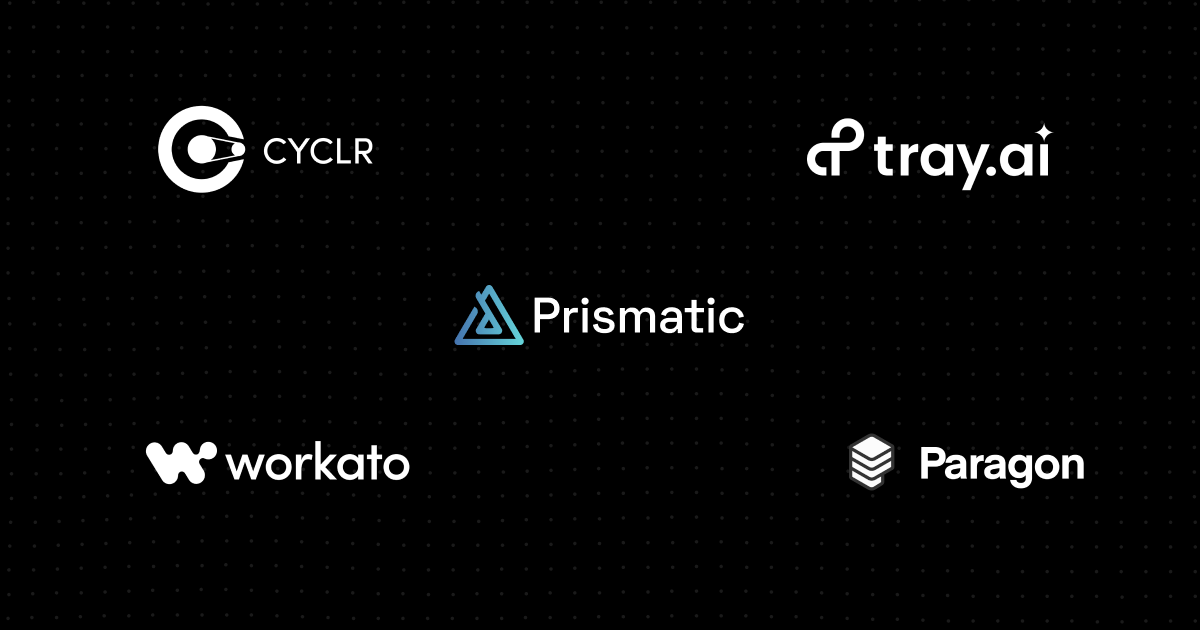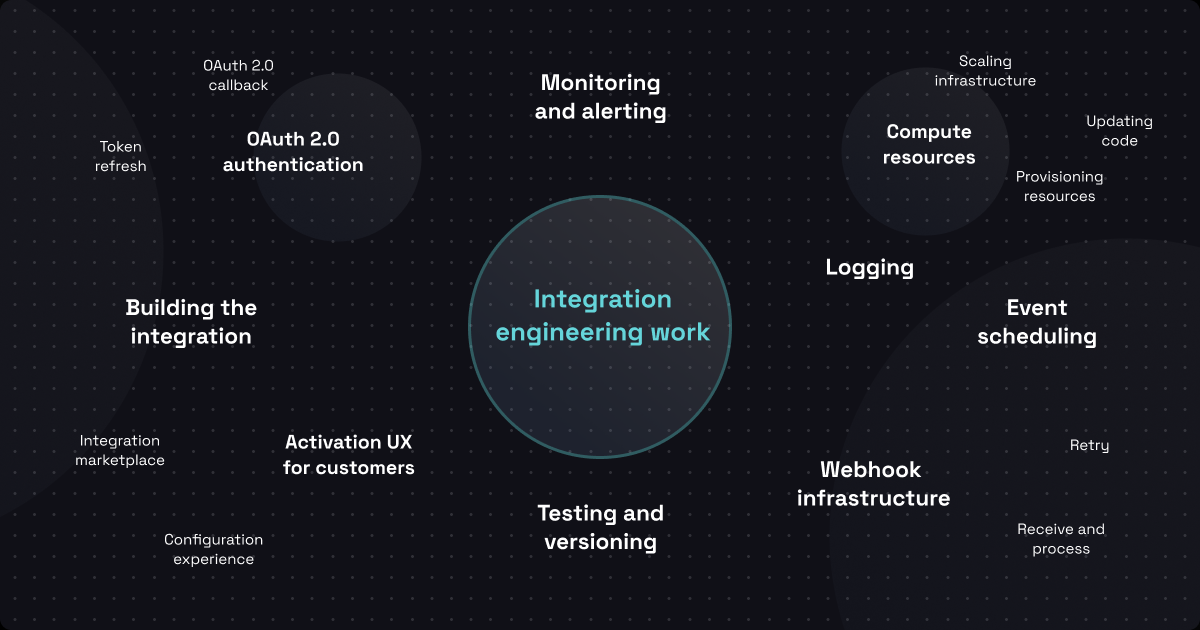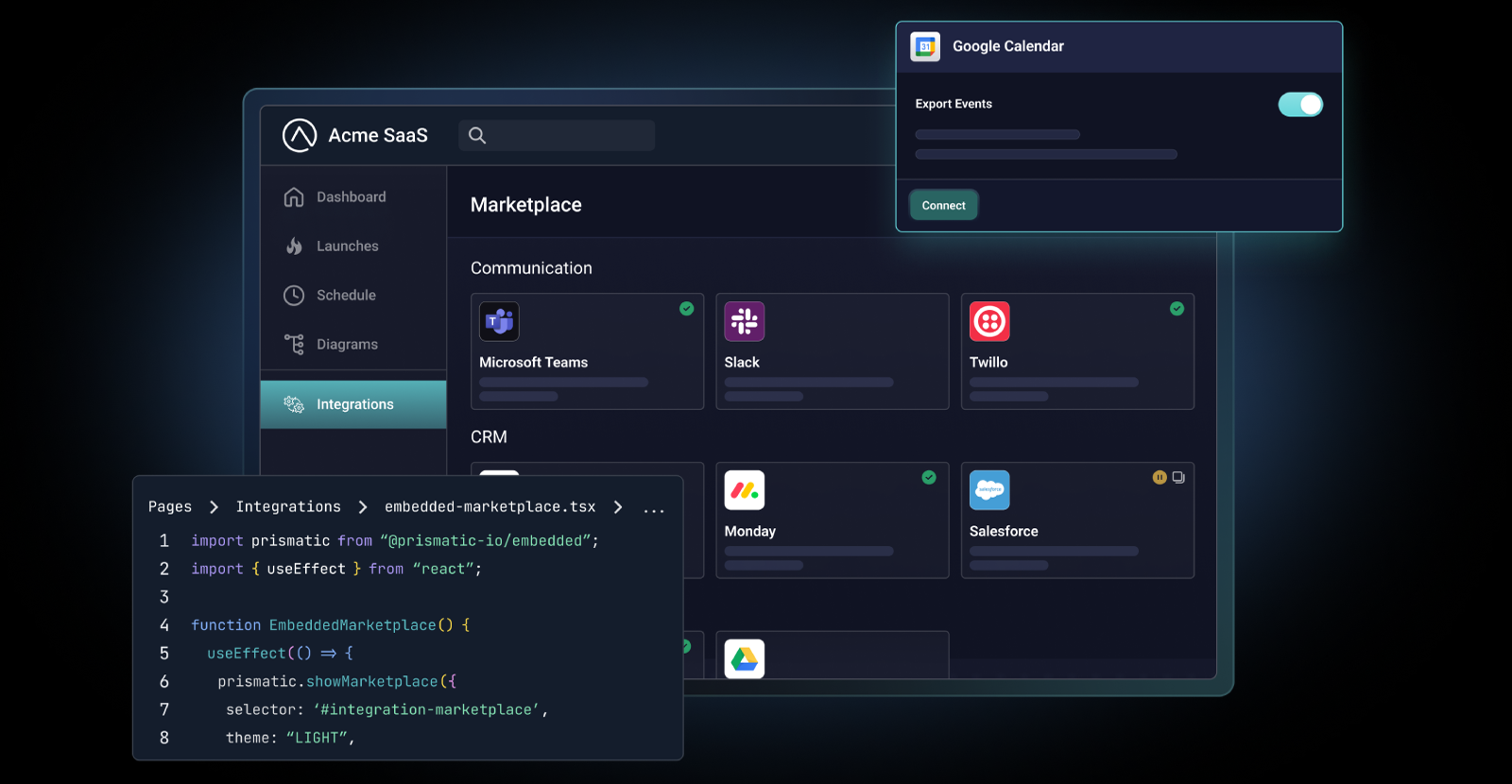Integrations remain the backbone of B2B SaaS, but the pace of change is accelerating.
More than a decade ago, the first vendors entered the enterprise iPaaS market. Then, we saw the introduction of unified APIs. Finally, the embedded iPaaS for B2B SaaS apps was defined separately from them both.
These tools and others have been developed and refined to help companies solve increasingly complex integration challenges. And integrations aren't going anywhere.
As the integration space matures and picks up speed, here are five trends to consider.
1. The proliferation of SaaS apps will continue to drive the need for integrations
There are more than 17,000 SaaS companies in the US, with global numbers coming in at 30,000. This number doesn’t appear to include the thousands of AI apps that have been launched in recent months.
Why so many apps? In part, this is due to the democratization of app development. As the barriers to building apps continue to drop, it only takes a handful of people to turn an idea into an app that competes in the global marketplace.
Today's average company relies on 112 SaaS apps (though other sources will multiply that by two or three). Regardless of which number one chooses, it is clear that modern business can’t function without a huge number of SaaS apps.
And, as noted, we have had an absolute explosion of AI-related SaaS apps over the last few months. Some of these are already providing real value for customers. Others are taking advantage of the current excitement around the topic of AI.
Meanwhile, demand for integrations both inside and outside the enterprise continues to grow. This report from Precedence Research notes that:
"The global data integration market size accounted for USD 15.24 billion in 2024 and expected to exceed USD 47.60 billion by 2034."
That's three-fold growth in 10 years, and likely understated, given the pace of AI development. Outside of what AI can do to facilitate integrations, AI agents (such as LLMs) are voracious consumers of data, much of which will be provided via integrations.
2. Integrations provided by SaaS apps out of the box will increase
Tied into the previous trend and companies' increasing reliance on the best-of-breed approach to selecting their apps, SaaS vendors realize they must bring their apps to the market with the integrations that customers expect.
As a result, modern SaaS apps and web services use integrations extensively. Without them, apps turn into data silos – and data silos make life more complicated for your customers. As a result, these native integrations have become table stakes.
IT teams increasingly say something like, "We could build these integrations internally, but it’s a whole lot simpler for any new SaaS apps we get to have integrations built in."
A few years ago, it was common to see new apps appear on the market without any integrations. And while this still happens, it's less common than it once was.
Initial go-to-market plans may not include integrations, but SaaS teams need answers for how and when they'll provide integrations for their customers.
In fact, in a recent survey, SaaS companies noted their customers used an average of 5 integrations between their product and other apps.
This trend will only grow stronger as vendors strive to capture sufficient market share to make themselves viable long-term.
3. Integration solutions will continue to evolve to serve specific needs
Building integrations in-house from scratch is a time-tested approach. And, as companies manage risk down, it can be very attractive to turn their devs loose on integrations. However, in most cases, writing and setting up everything needed to build, deploy, and manage integrations may not be the best use of internal resources.
Companies can now use one of several types of platforms to create the integrations their users and their customers need.
Here are a few of the most common integration platforms available today.
- Enterprise iPaaS – This type of solution enables the development, deployment, and support of integrations inside your company. This platform connects apps via integrations between internal business systems. It is primarily used by IT personnel, though non-technical teams may also use a low-code/no-code integration designer.
- Workflow Automation – While this broader term could encompass all the other categories, it can also be a category to itself. Tools such as Zapier fit this category better than any other. Zapier is a platform that can be used for integrations inside and outside the enterprise but is primarily the choice of individuals who need to integrate common apps from their desktops.
- Embedded iPaaS – This set of tools enables a software company to quickly build reusable, configurable integrations from its product to any app in any software category and deliver them to its customers as an essential part of its product. Technical and non-technical teams use it to create product integrations for B2B SaaS companies.
- Unified API – This platform connects several APIs in a standard software category to a single API to simplify the integration process. B2B SaaS companies use unified APIs for integrations with multiple apps in a single horizontal category (example: HRIS). Unified APIs are used by technical and non-technical teams.
In addition to the above, there are products that don't fit easily into any of the above categories as software companies forge new paths in pursuit of AI-driven value. Whether they will end up creating new categories, remain niche solutions, or eventually fall back into one of these common categories is something we can't know in the short term.
4. Integration tools will increasingly target specific user types
The introduction of low-code/no-code tools for building integrations was revolutionary. This advancement made integration development accessible for a whole new group of users: non-devs. Today, non-devs often use drag-and-drop integration designers to connect Well-known App A with Well-known App B.
Then there are the technical non-devs who need to create integrations. These are the same people who use Crystal Reports or Power BI to build reports. While not comfortable writing code from scratch, they are willing and able to change inputs and outputs, adjust configurations, and, yes, even tweak a bit of code occasionally.
Finally, we have devs who use IDEs to write code. Not only are they uncomfortable using a low-code UI, but find that it throttles their productivity and creativity. As a result, they want an integration building experience that lets them write code from start to finish in the tools they already know.
Now that AI appears to be on the brink of democratizing coding, where non-devs will use AIs to write usable code, it seems likely non-devs will move toward the AI-enabled solutions and away from the the existing low-code/no-code integration development tools.
However, despite the move towards "vibe coding" (or whatever AI-driven coding ends up being called), code-native integration building tools enhanced with AI capabilities will become increasingly important for handling the evolving needs of real-world integrations.
5. AI will play an increasing role in integration solutions
We anticipate that AI interactions with integrations will only increase. At present, AI can provide value in speeding up the integration build process and in creating more complex and powerful workflows. It's probable that we've only seen the beginning of what AI can do to provide real value within the integration space.
The number of AI-based companies is quickly expanding, with some putting the number as high as 70,000 worldwide. However, the market is very volatile, with more AI companies being created daily while other ones started just a few months ago are on their way out because they've not found a real problem to solve.
A number of companies that were previously focused on integrations (whether enterprise iPaas, embedded iPaaS, or one of the other categories have rebranded themselves as AI-first software companies. It remains to be seen whether they will be successful with this pivot, but the fact remains that the market currently expects much from the AI functionality currently being touted as the future of software.
AI systems such as Azure OpenAI and OpenAI are used within integrations as endpoints. And, of course, the key to AI is lots of data, so we see integrations being used to collect massive amounts of data for training AIs.
At present, AI agents are already proving their worth as tools that remove the monotony from creating integrations, freeing up devs to perform the more intricate work involved with integrations. AIs will become better at predicting integration patterns and more useful for all sorts of integration-related tasks.
How will you provide value to your customers?
Trends come and go. However, your B2B SaaS customers will be here for as long as they continue receiving exceptional value from your product.
One of the ways to provide that value is by ensuring that your product has essential integrations available on day one, and that you can provide additional integrations as your customers and their needs continue to evolve.
Using Prismatic allows you to provide integrations directly within your app, ensuring that your customers don't need to go anywhere else to view, configure, and activate all the integrations they need between your product and the other apps they use.
Schedule a demo, and let us show you how Prismatic can help you create integration value for your customers, increase product stickiness, and set your product up for long-term success.




